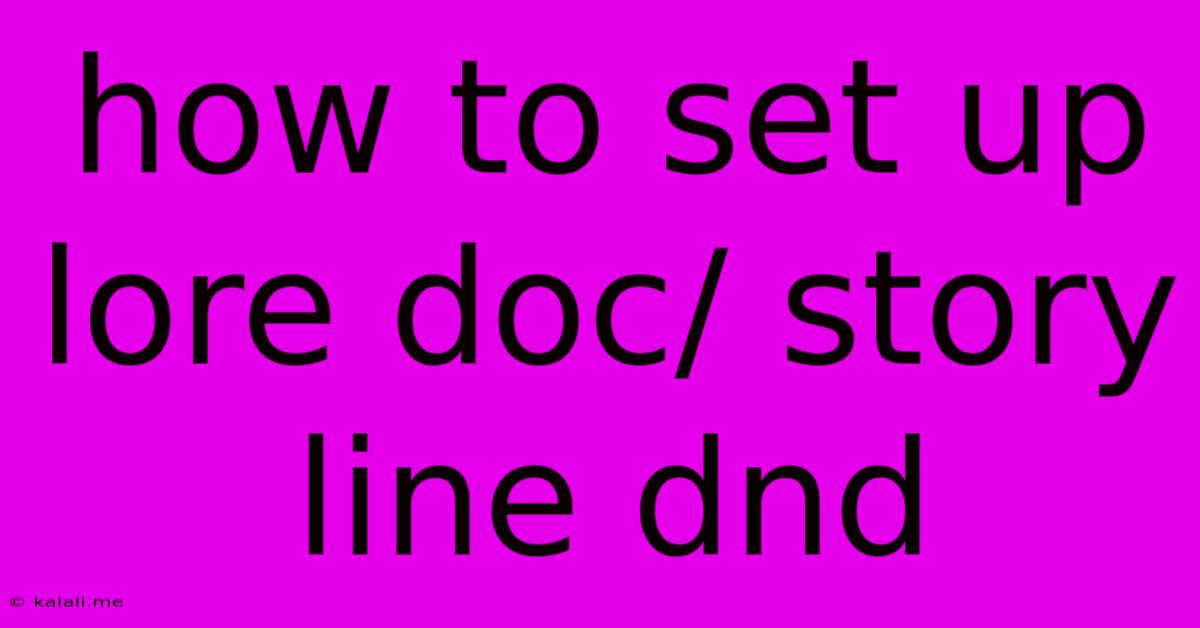How To Set Up Lore Doc/ Story Line Dnd
Kalali
Jun 11, 2025 · 4 min read

Table of Contents
Crafting a Compelling D&D Campaign: How to Set Up Your Lore Doc and Storyline
So, you're ready to run a Dungeons & Dragons campaign, but feel overwhelmed by the sheer amount of world-building involved? Don't worry, many Dungeon Masters (DMs) feel the same way! This article will guide you through creating a comprehensive lore document and crafting a captivating storyline that will keep your players engaged and wanting more. We'll cover everything from brainstorming initial ideas to structuring your lore document for easy access during your sessions.
A well-structured lore document, often referred to as a campaign bible, is essential for any successful D&D campaign. It serves as your central repository of information, ensuring consistency and immersion in your world. This isn't just about the history of your world; it's about creating a living, breathing universe for your players to explore and interact with.
I. Brainstorming and Concept Development: The Seeds of Your World
Before diving into the nitty-gritty details, it's crucial to brainstorm the core elements of your D&D world. Consider these key aspects:
- Setting: What kind of world are you creating? Is it a high fantasy realm filled with magic and mythical creatures, a gritty urban fantasy setting, or something completely unique? Defining your setting establishes the tone and possibilities for your adventures.
- Central Conflict: What is the main driving force of your story? This could be a looming war, a malevolent cult, a natural disaster, or a political conspiracy. A clear central conflict provides a strong backbone for your campaign.
- Major Factions: Who are the key players in your world? Consider kingdoms, religious orders, guilds, criminal organizations, and other influential groups. Understanding their motivations and relationships will add depth and complexity to your narrative.
- Important NPCs: Develop memorable non-player characters (NPCs) with their own backstories, motivations, and relationships. These characters will interact with your players, driving the plot forward and enriching their experience.
Pro Tip: Use mind maps or free-form brainstorming to generate ideas. Don't censor yourself at this stage; focus on quantity over quality. You can refine your concepts later.
II. Structuring Your Lore Document: Organizing the Chaos
Now that you have some core ideas, it's time to organize them into a structured lore document. A well-organized document will make your life significantly easier during your sessions. Consider these sections:
- World Overview: A concise summary of your world, including its geography, history, and overall tone.
- History: A detailed timeline of significant events, focusing on moments that shape the present and might impact future adventures.
- Geography: Describe the key locations in your world, including cities, towns, wilderness areas, and points of interest. Include maps if possible!
- Factions & Organizations: Detailed descriptions of major factions, including their goals, members, and relationships with other groups.
- Important NPCs: Detailed profiles of key NPCs, including their appearance, personality, motivations, and relationships with other characters.
- Magic System (if applicable): If your campaign incorporates magic, define its rules and limitations.
- Monster Manual Additions: If you plan on introducing custom monsters or significantly altering existing ones, document them here.
III. Crafting a Compelling Storyline: Keeping Players Engaged
With your lore document established, you can now focus on structuring your campaign's storyline. This involves:
- Creating a Series of Adventures: Break down your central conflict into smaller, manageable adventures. Each adventure should have a clear beginning, middle, and end.
- Developing Hooks: Design compelling hooks to draw your players into each adventure. These could be rumors, cryptic messages, or direct encounters with key NPCs.
- Incorporating Player Choice: Allow your players to make meaningful choices that impact the storyline. This will make them feel invested in the narrative and create a more memorable experience.
- Planning for Unexpected Turns: While having a plan is crucial, be prepared to improvise and adapt to your players' actions. This is where the lore document comes in handy – you can pull information from it to make decisions on the fly.
- Leaving Room for Mystery: Don't reveal everything at once. Leave some mysteries unsolved, allowing players to investigate and discover new things as the campaign progresses.
IV. Iteration and Refinement: The Living Document
Remember, your lore document and storyline are not static; they are living documents that will evolve as your campaign progresses. Be prepared to revise and update them based on your players’ choices and actions. The best campaigns are collaborative endeavors between the DM and the players. Embrace the unexpected and enjoy the journey!
By following these steps, you'll be well on your way to creating a captivating and memorable D&D campaign that will keep your players coming back for more. Happy gaming!
Latest Posts
Latest Posts
-
Mb Vs Gb Which Is Bigger
Jun 12, 2025
-
3 Input Or Gate Truth Table
Jun 12, 2025
-
Which Of The Following Describes An Outcome Of Russification
Jun 12, 2025
-
Moment Of Inertia Of Quarter Circle
Jun 12, 2025
-
Which Of The Following Is An
Jun 12, 2025
Related Post
Thank you for visiting our website which covers about How To Set Up Lore Doc/ Story Line Dnd . We hope the information provided has been useful to you. Feel free to contact us if you have any questions or need further assistance. See you next time and don't miss to bookmark.